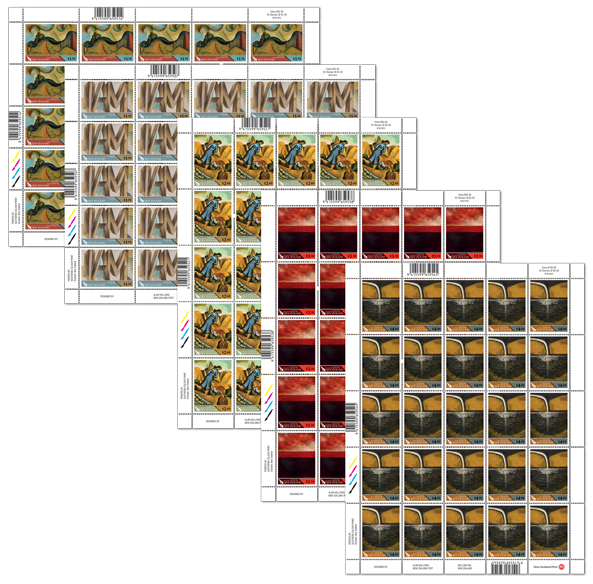Five Paintings by Colin McCohon.
Born in 1919‚ Colin McCahon grew up in Dunedin‚ always knowing he would be a painter. The distinctive power and originality of his images would make McCahon a giant of New Zealand painting, and today he is recognised internationally as one of Aotearoa’s most significant artists.
Colin McCahon was born in Timaru but spent most of his life in Auckland where he worked at the Auckland Art Gallery and taught at the Elam School of Art. McCahon began as a landscape painter, forming from this a visionary style featuring the placement of religious images and words against New Zealand backdrops. This issue features five of his well-recognised works.
The Stamps.
$1.30 - I Am.
Oil on jute canvas, 1954. I Am was the first of many paintings by McCahon constructed entirely from words. Here his lettering draws on display advertising, movie credits and the multiple perspectives of Cubism.
$1.30 - Titirangi Landscape.
Oil on canvas, 1954. In this joyful and strongly rhythmical evening landscape, McCahon explores the connections in shape between circular bouncy clouds lit by the late sun and the curvy shapes of the hills.
$2.60 - The Angel of the Annunciation.
Oil on cardboard ‚ 1947. In 1947-1948 McCahon startled audiences with radically unfamiliar paintings based on biblical stories. McCahon placed the figures within a local landscape and treated them in a style that proved highly controversial.
$3.30 - Red and Black Landscape.
Enamel with sand on hardboard, 1959. In 1958 McCahon spent time in the United States observing both contemporary and historical paintings. On returning his method changed radically, here using enamel house paint and sand on hardboard.
$4.00 - The First Waterfall.
Oil on jute on board‚ 1964. McCahon wrote: “The waterfalls started flowing in 1964… I look back with joy on taking a brush of white paint and curving through the darkness with a line of white.
Other Collectible Items.
First Day Cover - 3 July 2019.
The FDC featured a photograph of Colin McCahon with all five stamps attached.
The Miniature Sheet.
Miniature Sheet FDC - 3 July 2019.
Another photo of Colin McCahon is shown on this cover.
Presentation Pack
Learn more about Colin McCahon’s life from writer, editor and curator Peter Simpson. Peter has published several books on McCahon and curated several McCahon exhibitions. In 2017 Peter received the Prime Minister’s Award for Literary Achievement in Non-Fiction. In 2019 he will publish Colin McCahon: There Is Only One Direction: Volume One 1919-1959. A second volume, Colin McCahon: Is This The Promised Land?: Volume Two 1960-1987 will follow in 2020.
Set of Full Sheets.
Set of Plate Blocks. Set of Value Blocks.
Technical information.
Date of issue: 3 July 2019.
The number of stamps: Five gummed stamps.
Denominations: $1.30 x 2, $2.60, $3.30, $4.00.
Stamps, miniature sheet and first day covers designed: Alan Hollows, New Zealand Post, Wellington, New Zealand.
Printer and process: Southern Colour Print, Dunedin, New Zealand by offset lithography.
The number of colours: Four process colours.
Stamp size and format: 46mm x 35mm (two vertical, three horizontal).
Miniature sheet size and format: 145mm x 95mm (horizontal).
Paper Type: Tullis Russell 104gsm red phosphor gummed stamp paper
The number of stamps per sheet: 25.
Perforation gauge: 14.286 x 14.47.
Period of sale: Unless stocks are exhausted earlier, these stamps will remain on sale until 2 July 2020. First-day covers will remain on sale until 28 August 2019.
Some of the images in this post were used with permission from the illustrated catalogue of StampsNZ
Information & images for this post came from.













Comments
Post a Comment
We appreciate your engagement with our content. To ensure a respectful and constructive community, please take note of the following:
- No Spam, Please: We do not tolerate spammy or promotional comments. Any such comments will be promptly removed.
- Moderation in Place: All comments are moderated to maintain a positive and inclusive environment. Please be patient, as it may take a little time for your comment to appear.
- Sign In with Google: To comment, please sign in using your Google account. This helps us maintain the integrity of our community and allows for better interaction.